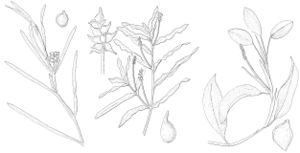Potamogeton crispus
Sp. Pl. 1: 126. 1753 (as crispum).
Rhizomes absent. Cauline stems flattened, without spots, to 100 cm; nodal glands absent. Turions common, axillary or terminal, 1.5–3 × ca. 2 cm, hard; leaves 2-ranked; outer leaves 1–4 per side, base not corrugate, apex rounded; inner leaves rolled into linear, terete structure, oriented parallel to outer leaves. Leaves submersed, spirally arranged, sessile, lax; stipules persistent to deliquescent, inconspicuous, convolute, free from blade, brownish, not ligulate, to 0.5 cm, not fibrous, not shredding at tip, apex obtuse; blade light to dark green, linear, not arcuate, 1.2–9 cm × 4–10 mm, base obtuse to rounded, without basal lobes, not clasping to nearly clasping, margins conspicuously serrate, not crispate, apex not hoodlike, round to round-acute, lacunae in 2–5 rows each side of midrib; veins 3–5. Inflorescences unbranched, emersed; peduncles not dimorphic, terminal or rarely axillary, erect to ascending, cylindric, 2.5–4 cm; spikes not dimorphic, cylindric, 10–15 mm. Fruits sessile, red to reddish-brown, obovoid, turgid to slightly concave, not abaxially or laterally keeled, 6 × 2.5 mm; beak apically recurved, 2–3 mm; sides without basal tubercles; embryo with 1 full spiral. 2n = 52 (Europe).
Phenology: Flowering spring–summer.
Habitat: Quiet waters, especially brackish, alkaline, or eutrophic waters of ponds, lakes, and streams
Elevation: 0–2000 m
Distribution

Introduced; Alta., B.C., Ont., Que., Sask., Ala., Ariz., Ark., Calif., Conn., Del., D.C., D.C., Fla., Ga., Ill., Ind., Iowa, Kans., Ky., La., Maine, Md., Mass., Mich., Minn., Mo., Nebr., Nev., N.H., N.J., N.Y., N.C., Ohio, Okla., Oreg., Pa., R.I., S.Dak., Tenn., Tex., Utah, Vt., Va., Wash., W.Va., Wis., Wyo., Central America (Costa Rica), South America (Colombia), South America (and Argentina), Eurasia, Australia
Discussion
No specimens have been seen from New Brunswick, but the species is to be expected there.
Potamogeton crispus, an introduced species, has spread throughout much of North America. The expansion of this species’s range from its original collection in North America, apparently about 1840, has been discussed (R. L. Stuckey 1979). This is the only species of pondweeds in North America with serrate leaves and consequently it is easily recognized.
Life history of Potamogeton crispus is unusual as it flowers and fruits in late spring and early summer, at which time it also produces turions. The plants decay shortly after those structures develop, leaving only fruits and turions, which survive the summer. No one has observed any seed germination, but the turions (referred to as dormant apices) germinate in late summer or fall, and the plants overwinter as small plants only a few cm centimeters in size, even under the ice in northern climates (R. L. Stuckey et al. 1978). Growth then continues as the water begins warming in the spring.
One hybrid, Potamogeton crispus × P. praelongus (= P. × undulatus Wolfgang ex Schultes & Schultes f.), has been described.
Selected References
Lower Taxa
"shortened" is not a number."not elongating" is not a number."less" is not a number.
